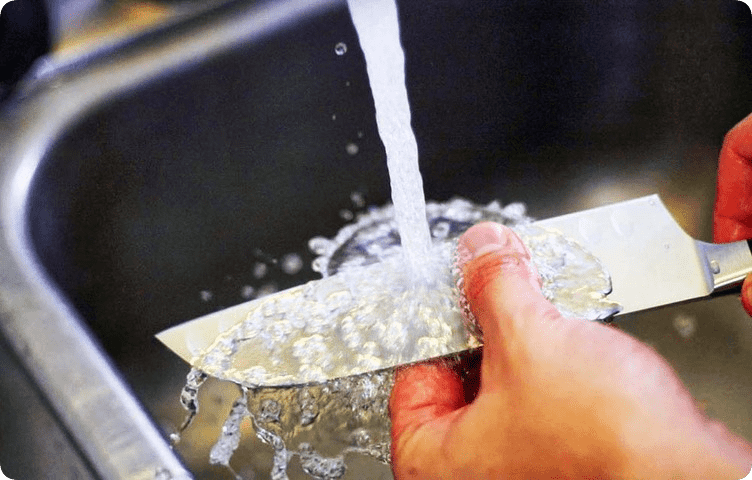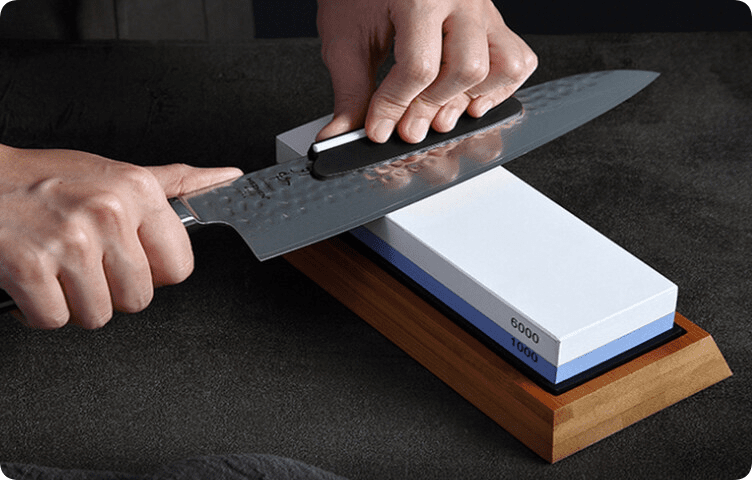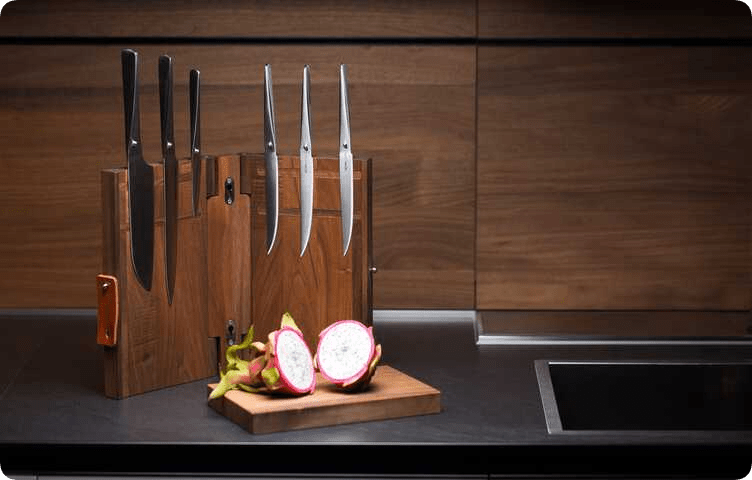A comfortable knife is the basis for quick work in the kitchen. A well-sharpened blade cuts without effort, but it is impossible to get hurt. But even experienced chefs do not always know how to care for a knife - wash, clean, sharpen. But if you take care of your kitchen tool correctly, it will last 10-30 years.
Basic rules for using knives
The first condition is the absolute cleanliness of the blade. Good knife blades are made from stainless or high-carbon steel, making them less susceptible to corrosion. But if you leave the product dirty after use, acid and water will corrode the metal.
Wash knives only by hand using a sponge and a mild detergent. Washing in the dishwasher is excluded, as it gradually destroys the wooden and plastic handles. Hand washing cleaning also allows you to notice any dirt remaining between the blade and handle.

Here are three more important tips:
- wipe the tool dry so that the blade does not rust;
- Use the knife only with wooden, bamboo, or plastic cutting boards. Glass products quickly dull the cutting edge;
- Sharpen the cutting edge regularly. Treatment with a whetstone or a special sharpener prevents the formation of tiny dents and chips that contribute to metal corrosion.
A blade made of carbon steel needs to be lubricated with vegetable oil from time to time. This creates a protective film on the surface of the product, preventing the formation of rust.
How to care for knife handles?
Kitchen utensil manufacturers usually make knife handles from wood or plastic. Wood is stronger, more comfortable to the touch, but more demanding to maintain. No matter how often the product is used, the wood gradually dries out. To slow down this process, the handle must be periodically lubricated with mineral or Danish oil. This prevents the appearance of cracks and increases resistance to moisture. If the handle is made of expensive wood, oiling will highlight the beautiful grain pattern of the wood.
A couple of drops of oil are enough for proper care. Rub it in with a soft, clean cloth until completely absorbed. It is better to do this in the evening so that the knife is fully usable the next day.
It is enough to wash the plastic handle regularly with a sponge and detergent. Old dirt can be easily removed with baking soda or a mixture of 9% vinegar and water (1:1 ratio).
How to care for folding knives?
The first rule of care is to use the tool only for its intended purpose. Do not tighten screws with the tip or open bottles. Such actions lead to curvature of the blade. The cutting edge must be sharpened regularly, processing the main bevel.
The carbon steel from which knife blades are made requires protection against corrosion. To prevent the blade from rusting, it must be washed after each use and wiped dry. Periodically, the metal is lubricated with gun oil or pharmaceutical castor oil.
Often the folding mechanism breaks when dirt accumulates inside the hinge - food particles, fabric lint from pockets. Small specks can be removed with a hairdryer. If the contamination is heavy, the hinge assembly will have to be disassembled and all parts cleaned separately.
The hinges need to be lubricated periodically. After first rinsing with a stream of water, dry the product with a hairdryer, then drop a little gun oil into the mechanism. After 10 minutes, wipe with a soft cloth.
How to care for fixed blade knives
If the knife blade is fixedly attached to the handle, the tool is called fixed. There are five main types of such products:
- large – distinguished by a wide, heavy blade. Suitable for any operation - slicing bread, shredding, chopping meat;
- small – equipped with a triangular blade with an arched edge;
- vegetable – narrow, sharp, used for peeling vegetables;
- universal - a medium-sized knife with a beveled spine. Used for cutting any products;
- bread - a long straight tool equipped with a wavy edge.
All types of knives must be washed immediately after use, carefully removing dirt from the junction of the blade and the handle. Then wipe the knife blade dry. From time to time the tool must be lubricated with special oil.
About sharpening knives
A dull blade not only slows down your slicing, but is also potentially dangerous. It requires additional effort and slips, which can cause injury to the cook. That's why the cutting edge needs to be sharpened regularly - at least once a week if the tool is used at home.
There are three tools for sharpening a blade:
- A whetstone is a block of natural or artificial material harder than metal, with a grainy surface. The stone is placed on a wet boombig towel. The blade is moistened with water, applied to the stone, tilted 20 degrees, with the tip facing away from you. Move in a circular motion 3-4 times, then turn and repeat on the other side. The operation is performed again, turning the stone over with the smoother side up;

- Musat is a tool that resembles a narrow file made of metal or ceramic coated with diamond. It is installed vertically, resting the tip against a hard surface. Run the cutting edge along the musat, 4-5 times on each side;
- A mechanical or electric sharpener is a tool consisting of hard disks enclosed in a housing with slots. The device helps sharpen blades effortlessly while simultaneously leveling the blade.
Expensive knives, including hunting and collectibles, are recommended to be sharpened by a professional service.
Corrosion removal
If rust appears on the blade, it can be removed with an anti-corrosion agent. It is applied to rusty metal, left for 20-30 minutes, then cleaned off. The most effective rust converters are AVS AVK, Elcon, Runway.
Home remedies also work well against rusty deposits, for example:
- baking soda;
- an aqueous solution of 9 percent vinegar in a 1:1 ratio;
- lemon juice;
- raw potatoes;
- onion.
Home remedies are left on the rusty knife for 30-40 minutes, cleaned with a sponge, and washed.
Stubborn rust stains can be removed with sandpaper or steel wool. The cleaned blade is lubricated with Vaseline oil, and after 10 minutes, thoroughly wiped with a dry cloth.
Rules for storing knives
When choosing a place for kitchen tools, it is important to comply with two conditions - convenience and safety. The sharp edges should not rub against a hard surface when you take out the knife. Preference should be given to stable stands that cannot accidentally tip over.
The three most popular storage locations are:
- drawer - contains inside special dividers made of wood or plastic;
- knife block - a vertical stand with holes for blades;
- magnetic tape – keeps products suspended on the wall.

Cutting tools are stored separately from other kitchen utensils. Storage containers are installed where it is convenient for the cook to take them. The place should be spacious enough and inaccessible to children.
Hunting and camping knives should not be stored in leather sheaths. When in contact with the skin for a long time, the metal becomes saturated with tannins, causing dark spots. The sheath is used only for carrying the instrument.
















































/https%3A%2F%2Fcomplexbar.com%2Fimages%2Fblog%2F131%2Fnozhi-article.jpg)
/https%3A%2F%2Fcomplexbar.com%2Fimages%2Fblog%2F245%2Fskov_glavn.jpeg)
/https%3A%2F%2Fcomplexbar.com%2Fimages%2Fblog%2F245%2Fhaiboli.jpg)
/https%3A%2F%2Fcomplexbar.com%2Fimages%2Fblog%2F245%2Fvilki-na-stole-752x480.jpeg)
/https%3A%2F%2Fcomplexbar.com%2Fimages%2Fblog%2F246%2F2024-04-09_17.22.54.jpg)
/https%3A%2F%2Fcomplexbar.com%2Fimages%2Fblog%2F246%2F2024-04-09_17.22.47.jpg)
/https%3A%2F%2Fcomplexbar.com%2Fimages%2Fblog%2F246%2FCODE_anons_foamydrops_752%D1%85480_eng.jpg)
/https%3A%2F%2Fcomplexbar.com%2Fimages%2Fblog%2F246%2FAlina_752%D1%85480_eng.jpg)
/https%3A%2F%2Fcomplexbar.com%2Fimages%2Fblog%2F246%2F2024-04-09_17.23.22.jpg)
/https%3A%2F%2Fcomplexbar.com%2Fimages%2Fblog%2F246%2F2024-04-09_17.23.28.jpg)
/https%3A%2F%2Fcomplexbar.com%2Fimages%2Fblog%2F246%2F2024-04-09_17.23.35.jpg)
/https%3A%2F%2Fcomplexbar.com%2Fimages%2Fblog%2F246%2Fdrinksome_752%D1%85480_eng.jpg)
/https%3A%2F%2Fcomplexbar.com%2Fimages%2Fblog%2F246%2Fnude_752%D1%85480_eng.jpg)
/https%3A%2F%2Fcomplexbar.com%2Fimages%2Fblog%2F246%2F752%D1%85480_eng__1_.jpg)
/https%3A%2F%2Fcomplexbar.com%2Fimages%2Fblog%2F246%2F752%D1%85480_eng.jpg)
/https%3A%2F%2Fcomplexbar.com%2Fimages%2Fblog%2F246%2FStudioRaw_752%D1%85480_eng.jpg)
/https%3A%2F%2Fcomplexbar.com%2Fimages%2Fblog%2F246%2FDoppio_tea_752%D1%85480_eng.jpg)
/https%3A%2F%2Fcomplexbar.com%2Fimages%2Fblog%2F246%2FTognana_Stars_Stripes_752%D1%85480_eng.jpg)
/https%3A%2F%2Fcomplexbar.com%2Fimages%2Fblog%2F246%2FRona_752%D1%85480_eng.jpg)
/https%3A%2F%2Fcomplexbar.com%2Fimages%2Fblog%2F246%2FDoppio_vending_752%D1%85480_eng.jpg)
/https%3A%2F%2Fcomplexbar.com%2Fimages%2Fblog%2F246%2FEssence_sukhie_smesi_752%D1%85480_eng.jpg)
/https%3A%2F%2Fcomplexbar.com%2Fimages%2Fblog%2F246%2FODK_sukhie_smesi752%D1%85480_eng.jpg)
/https%3A%2F%2Fcomplexbar.com%2Fimages%2Fblog%2F246%2Funiforma-barmena.jpg)
/https%3A%2F%2Fcomplexbar.com%2Fimages%2Fblog%2F246%2Fkak-nanyat-barmena.jpg)
/https%3A%2F%2Fcomplexbar.com%2Fimages%2Fblog%2F246%2Fsirop_scale_2400.jpeg)
/https%3A%2F%2Fcomplexbar.com%2Fimages%2Fblog%2F246%2FPeugeot_Anons_Paris_U%27Select_Line_Daman_752%D1%85480_eng.jpg)
/https%3A%2F%2Fcomplexbar.com%2Fimages%2Fblog%2F246%2Fkofe-vostochniy.jpg)
/https%3A%2F%2Fcomplexbar.com%2Fimages%2Fblog%2F246%2FMadler.jpg)
/https%3A%2F%2Fcomplexbar.com%2Fimages%2Fblog%2F246%2Fprofbartender_glavn.jpeg)